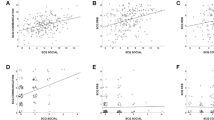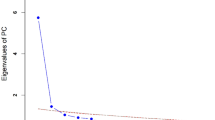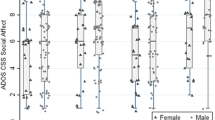Abstract
The magnitude of symptom inter-correlations in diagnosed individuals has contributed to the evidence that autism spectrum disorders (ASD) is a fractionable disorder. Such correlations may substantially under-estimate the population correlations among symptoms due to simultaneous selection on the areas of deficit required for diagnosis. Using statistical simulations of this selection mechanism, we provide estimates of the extent of this bias, given different levels of population correlation between symptoms. We then use real data to compare domain inter-correlations in the Autism Spectrum Quotient, in those with ASD versus a combined ASD and non-ASD sample. Results from both studies indicate that samples restricted to individuals with a diagnosis of ASD potentially substantially under-estimate the magnitude of association between features of ASD.
Similar content being viewed by others
References
Aitken, A. C. (1935). Note on selection from a multivariate normal population. Proceedings of the Edinburgh Mathematical Society (Series 2), 4(02), 106–110.
Alexander, R. A., Carson, K. P., Alliger, G. M., & Cronshaw, S. F. (1989). Empirical distributions of range restricted SD x in validity studies. Journal of Applied Psychology, 74(2), 253.
Allison, C., Auyeung, B., & Baron-Cohen, S. (2012). Toward brief “red flags” for autism screening: The short autism spectrum quotient and the short quantitative checklist in 1,000 cases and 3,000 controls. Journal of the American Academy of Child and Adolescent Psychiatry, 51(2), 202–212.
American Psychiatric Association. (1994). Diagnostic and statistical manual of mental disorders (4th ed.). Washington, DC: American Psychiatric Association.
American Psychiatric Association. (2013). Diagnostic and statistical manual of mental disorders (5th ed.). Washington, DC: American Psychiatric Association.
Austin, E. J. (2005). Personality correlates of the broader autism phenotype as assessed by the Autism Spectrum Quotient (AQ). Personality and Individual Differences, 38(2), 451–460.
Baird, G., Simonoff, E., Pickles, A., Chandler, S., Loucas, T., Meldrum, D., et al. (2006). Prevalence of disorders of the autism spectrum in a population cohort of children in South Thames: The Special Needs and Autism Project (SNAP). The Lancet, 368(9531), 210–215.
Baron-Cohen, S., Scott, F. J., Allison, C., Williams, J., Bolton, P., Matthews, F. E., et al. (2009). Prevalence of autism-spectrum conditions: UK school-based population study. The British Journal of Psychiatry, 194(6), 500–509.
Baron-Cohen, S., Wheelwright, S., Skinner, R., Martin, J., & Clubley, E. (2001). The autism-spectrum quotient (AQ): Evidence from asperger syndrome/high-functioning autism, malesand females, scientists and mathematicians. Journal of Autism and Developmental Disorders, 31(1), 5–17.
Berry, C. M., Clark, M. A., & McClure, T. K. (2011). Racial/ethnic differences in the criterion-related validity of cognitive ability tests: A qualitative and quantitative review. Journal of Applied Psychology, 96(5), 881–906.
Booth, T., Murray, A. L., McKenzie, K., Kuenssberg, R., O’Donnell, M., & Burnett, H. (2013). Brief report: An evaluation of the AQ-10 as a brief screening instrument for ASD in adults. Journal of Autism and Developmental Disorders, 43(12), 2997–3000.
Brunsdon, V. E., & Happé, F. (2014). Exploring the ‘fractionation’of autism at the cognitive level. Autism, 18(1), 17–30.
Constantino, J. N., Gruber, C. P., Davis, S., Hayes, S., Passanante, N., & Przybeck, T. (2004). The factor structure of autistic traits. Journal of Child Psychology and Psychiatry, 45(4), 719–726.
Dominicus, A., Palmgren, J., & Pedersen, N. L. (2006). Bias in variance components due to nonresponse in twin studies. Twin Research and Human Genetics, 9(2), 185–193.
Dworzynski, K., Happé, F., Bolton, P., & Ronald, A. (2009). Relationship between symptom domains in autism spectrum disorders: A population based twin study. Journal of Autism and Developmental Disorders, 39(8), 1197–1210.
Fife, D. A., Mendoza, J. L., & Terry, R. (2012). The assessment of reliability under range restriction: A comparison of α, ω, and test–retest reliability for dichotomous data. Educational and Psychological Measurement, 72(5), 862–888.
Frazier, T. W., Youngstrom, E. A., Speer, L., Embacher, R., Law, P., Constantino, J., et al. (2012). Validation of proposed DSM 5 criteria for Autism Spectrum Disorder. Journal of the American Academy of Child and Adolescent Psychiatry, 51(1), 28–40.
Happé, F., & Ronald, A. (2008). The ‘fractionable autism triad’: A review of evidence from behavioural, genetic, cognitive and neural research. Neuropsychology Review, 18(4), 287–304.
Hobson, R. P. (2014). The coherence of autism. Autism, 18(1), 6–16.
Hoekstra, R. A., Bartels, M., Cath, D. C., & Boomsma, D. I. (2008). Factor structure, reliability and criterion validity of the Autism-Spectrum Quotient (AQ): A study in Dutch population and patient groups. Journal of Autism and Developmental Disorders, 38(8), 1555–1566.
Hoekstra, R. A., Vinkhuyzen, A. A., Wheelwright, S., Bartels, M., Boomsma, D. I., Baron-Cohen, S., et al. (2011). The construction and validation of an abridged version of the autism-spectrum quotient (AQ-Short). Journal of Autism and Developmental Disorders, 41(5), 589–596.
Hunter, J. E., Schmidt, F. L., & Le, H. (2006). Implications of direct and indirect range restriction for meta-analysis methods and findings. Journal of Applied Psychology, 91(3), 594.
Kolevzon, A., Smith, C. J., Schmeidler, J., Buxbaum, J. D., & Silverman, J. M. (2004). Familial symptom domains in monozygotic siblings with autism. American Journal of Medical Genetics Part B: Neuropsychiatric Genetics, 129(1), 76–81.
Kuenssberg, R., Murray, A. L., Booth, T., & McKenzie, K. (2014). Structural validation of the abridged Autism Spectrum Quotient-Short Form in a clinical sample of people with autism spectrum disorders. Autism, 18(2), 69–75.
Lai, M. C., Lombardo, M. V., Pasco, G., Ruigrok, A. N., Wheelwright, S. J., Sadek, S. A., et al. (2011). A behavioral comparison of male and female adults with high functioning autism spectrum conditions. PLoS ONE, 6(6), e20835.
Lawley, D. N. (1944). A note on Karl Pearson’s selection formulae. Proceedings of the Royal Society of Edinburgh. Section A. Mathematical and Physical Sciences, 62(1), 28–30.
Lundström, S., Chang, Z., Råstam, M., Gillberg, C., Larsson, H., Anckarsäter, H., et al. (2012). Autism spectrum disorders and autistic-like traits: Similar etiology in the extreme end and the normal variation. Archives of General Psychiatry, 69(1), 46–52.
Maenner, M. J., Rice, C. E., Arneson, C. L., Cunniff, C., Schieve, L. A., Carpenter, L. A., et al. (2014). Potential impact of DSM-5 criteria on autism spectrum disorder prevalence estimates. JAMA Psychiatry, 71(3), 292–300.
Mandy, W., Charman, T., Puura, K., & Skuse, D. (2014). Investigating the cross-cultural validity of DSM-5 autism spectrum disorder: Evidence from Finnish and UK samples. Autism, 18(1), 45–54.
Mazefsky, C. A., Goin-Kochel, R. P., Riley, B. P., & Maes, H. H. (2008). Genetic and environmental influences on symptom domains in twins and siblings with autism. Research in Autism Spectrum Disorders, 2(2), 320–331.
Murray, A. L., Booth, T., McKenzie, K., Kuenssberg, R., & O’Donnell, M. (2014). Are Autistic traits measured equivalently in individuals with and without an Autism Spectrum Disorder? An invariance analysis of the Autism Spectrum Quotient Short Form. Journal of Autism and Developmental Disorders, 44(1), 55–64.
Muthén, B. (1990). Moments of the censored and truncated bivariate normal distribution. British Journal of Mathematical and Statistical Psychology, 43(1), 131–143.
Pearson, K. (1903). Mathematical contributions to the theory of evolution. XI. On the influence of natural selection on the variability and correlation of organs. Philosophical Transactions of the Royal Society of London. Series A, Containing Papers of a Mathematical or Physical Character, 200, 1–66.
Rivet, T. T., & Matson, J. L. (2011). Review of gender differences in core symptomatology in autism spectrum disorders. Research in Autism Spectrum Disorders, 5(3), 957–976.
Robinson, E. B., Koenen, K. C., McCormick, M. C., Munir, K., Hallett, V., Happé, F., et al. (2012). A multivariate twin study of autistic traits in 12-year-olds: Testing the fractionable autism triad hypothesis. Behavior Genetics, 42(2), 245–255.
Rutter, M. (2014). Addressing the issue of fractionation in autism spectrum disorder: A commentary on Brunsdon and Happé, Frazier et al., Hobson and Mandy et al. Autism, 18(1), 55–57.
Sackett, P. R., & Yang, H. (2000). Correction for range restriction: An expanded typology. Journal of Applied Psychology, 85(1), 112–118.
R Core Team (2013). R: A language and environment for statistical computing. Vienna, Austria: R Foundation for Statistical Computing, ISBN 3-900051-07-0, URL:http://www.R-project.org/.
Schmidt, F. L., & Hunter, J. E. (1977). Development of a general solution to the problem of validity generalization. Journal of Applied Psychology, 62(5), 529–540.
Takagishi, H., Takahashi, T., Yamagishi, T., Shinada, M., Inukai, K., Tanida, S., et al. (2010). Salivary testosterone levels and autism-spectrum quotient in adults. Neuroendocrinology Letters, 31(6), 101–105.
Taylor, A. (2004). The consequences of selective participation on behavioral-genetic findings: Evidence from simulated and real data. Twin Research, 7(05), 485–504.
Wheelwright, S., Auyeung, B., Allison, C., & Baron-Cohen, S. (2010). Research defining the broader, medium and narrow autism phenotype among parents using the Autism Spectrum Quotient (AQ). Molecular Autism, 1(10), 1–9.
Williams, D. M., & Bowler, D. M. (2014). Autism spectrum disorder: Fractionable or coherent? Autism, 18(1), 2–5.
Acknowledgments
Aja Louise Murray is supported by a studentship from The University of Edinburgh Centre for Cognitive Ageing and Cognitive Epidemiology, (http://ccace.ed.ac.uk), part of the cross council Lifelong Health and Wellbeing Initiative (G0700704/84698). Funding from the Biotechnology and Biological Sciences Research Council, Engineering and Physical Sciences Research Council, Economic and Social Science Research Council, and the Medical Research Council is gratefully acknowledged.
Conflict of interest
The authors have no conflict of interest to declare.
Author information
Authors and Affiliations
Corresponding author
Electronic supplementary material
Below is the link to the electronic supplementary material.
Rights and permissions
About this article
Cite this article
Murray, A.L., McKenzie, K., Kuenssberg, R. et al. Are We Under-Estimating the Association Between Autism Symptoms?: The Importance of Considering Simultaneous Selection When Using Samples of Individuals Who Meet Diagnostic Criteria for an Autism Spectrum Disorder. J Autism Dev Disord 44, 2921–2930 (2014). https://doi.org/10.1007/s10803-014-2154-2
Published:
Issue Date:
DOI: https://doi.org/10.1007/s10803-014-2154-2




